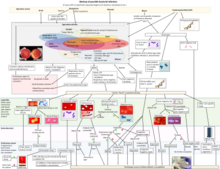CAMP test
The CAMP test (Christie–Atkins–Munch-Petersen) is a test to identify group B β-hemolytic streptococci (Streptococcus agalactiae)[1][2] based on their formation of a substance, CAMP factor,[3] that enlarges the area of hemolysis formed by the β-hemolysin elaborated from Staphylococcus aureus.
Though not strongly beta-hemolytic on its own,[6] group B strep presents with wedge-shaped colonies in the presence of Staphylococcus aureus.
[8] The reverse CAMP test is a method to identify Clostridium perfringens using β-hemolytic streptococci.
Streaking these two organisms perpendicular to each other on a blood agar plate will yield a “bow tie” shaped zone of hemolysis which indicates a positive test.
The name of the test bears no relationship to the name of the second messenger cyclic adenosine monophosphate (commonly referred to as cAMP).

